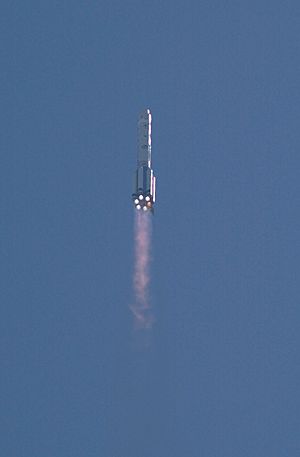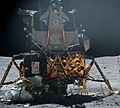Spaceflight facts for kids
Spaceflight is when something built by people, like a spacecraft, travels into outer space. These journeys can happen with or without humans inside.
For example, the Russian Soyuz program, the U.S. Space Shuttle, and the International Space Station are all about spaceflight with people. But many spaceflights don't have humans! Space probes and satellites that orbit the Earth are examples of unmanned (without humans) spaceflights. These are controlled by radio control or work on their own.
Spaceflight helps us explore space, like sending people to the Earth's moon or probes to other planets in our solar system. It's also used for space tourism and sending messages around the world using telecommunication satellites.
A spaceflight usually starts with a rocket launch. The rocket needs a lot of power to leave Earth's atmosphere and get into orbit. Once in space, scientists on Earth watch and study the spacecraft. Some spacecraft stay in space forever, while others break apart when they come back into Earth's atmosphere. A few even land on other planets!
Contents
First Steps into Space
The very first spaceflight happened on October 3, 1942. A German V-2 missile flew above the Kármán line, which is about 100 kilometers (62 miles) above Earth. This line is often seen as the edge of space.
Then, on October 4, 1957, Russia launched Sputnik 1. This was the first artificial (man-made) satellite to orbit Earth. It was a huge step for space exploration!
Why Do We Go to Space?
People go to space for many important reasons.
Exploring Our Universe
One big reason is to learn more about space. We send probes to distant planets to see what they are like. We also send telescopes into space to get clearer views of stars and galaxies without Earth's atmosphere getting in the way.
Helping Life on Earth
Satellites in space help us every day. They are used for:
- Communication: Sending phone calls, internet, and TV signals around the world.
- Weather: Tracking storms and helping us predict the weather.
- Navigation: Like the GPS in your phone, helping you find your way.
- Earth Observation: Watching how our planet changes, like tracking forests or ice.
Future of Spaceflight
Spaceflight is still growing! Scientists are working on new ways to travel to space, like reusable rockets. They are also planning missions to send humans back to the Moon and even to Mars. Maybe one day, you could be one of the people traveling to space!
Images for kids
-
Launched in 1959, Luna 1 was the first known artificial object to achieve escape velocity from the Earth. (replica pictured)
-
The MESSENGER spacecraft at Mercury (artist's interpretation)
-
ISS crew member stores samples
-
Astronauts on the ISS in weightless conditions. Michael Foale can be seen exercising in the foreground.
-
This shows an extreme ultraviolet view of the Sun (the Apollo Telescope Mount SO82A Experiment) taken during Skylab 3, with the Earth added for scale. On the right an image of the Sun shows a helium emissions, and there is an image on the left showing emissions from iron. One application for spaceflight is to take observation hindered or made more difficult by being on Earth's surface. Skylab included a massive crewed solar observatory that revolutionized solar science in the early 1970s using the Apollo-based space station in conjunction with crewed spaceflights to it.
See also
 In Spanish: Vuelo espacial para niños
In Spanish: Vuelo espacial para niños













